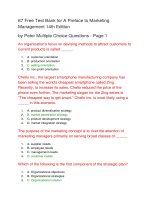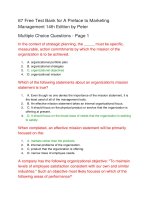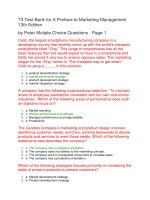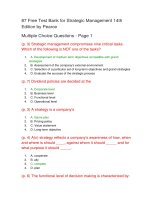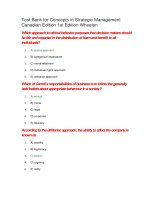Test bank of fred r david – strategic management, 13th edition ch08
Bạn đang xem bản rút gọn của tài liệu. Xem và tải ngay bản đầy đủ của tài liệu tại đây (256.35 KB, 432 trang )
Exam
Name___________________________________
TRUE/FALSE. Write 'T' if the statement is true and 'F' if the statement is false.
1)
Effective strategy formulation can usually guarantee successful strategy implementation.
1)
_______
2)
Strategy formulation is the managing of forces during the action, whereas strategy implementation is the
positioning of forces before the action.
2)
_______
3)
Strategy formulation requires coordination among a few individuals, but strategy implementation requires
coordination among many.
3)
_______
4)
It is always easier to say you are going to do something (strategy formulation) than to actually do it
(strategy implementation).
4)
_______
5)
Unlike strategy formulation, strategy implementation varies considerably among different types and sizes
of organizations.
5)
_______
6)
A bottom-up flow of communication is essential for developing top-down support.
6)
_______
7)
Annual objectives are key components in the strategic-management process because they dictate how
resources will be allocated.
7)
_______
8)
Horizontal consistency is more important than vertical consistency in developing annual objectives.
8)
_______
9)
Undesirable conduct such as distorting the record can be a result of overemphasis on achieving objectives.
9)
_______
10)
Policies refer to specific guidelines, methods, procedures, rules, forms, and administrative practices
established to support and encourage work toward stated goals.
10)
______
11)
Strategies clarify what can and cannot be done in pursuit of an organization's objectives.
11)
______
12)
Not allocating resources according to the priorities indicated by approved objectives is detrimental to the
strategic-management process.
12)
______
13)
Four types of resources that can be used to achieve desired objectives are financial, physical, human and
technological.
13)
______
14)
Avoidance, infusion and confrontation are the classifications for the various approaches for minimizing and
resolving conflict.
14)
______
15)
Conflict of any kind is avoidable in organizations.
15)
______
16)
Concerning managing and resolving conflict, defusion includes such actions as ignoring the problem in the
hope that the conflict will resolve itself.
16)
______
17)
Holding a meeting at which conflicting parties present their views and work through their differences is
part of the defusion strategy of managing conflict.
17)
______
18)
Exchanging members of conflicting parties so each can gain an appreciation of the other's point of view
exemplifies a confrontation approach.
18)
______
19)
Medium-sized firms tend to be divisionally structured, whereas large firms tend to use an SBU (strategic
business unit) or matrix structure.
19)
______
20)
Tasks and activities are grouped together by business function in a divisional organizational structure.
20)
______
21)
A functional structure can be effective at limiting short-term and narrow thinking.
21)
______
22)
Most large companies have abandoned the functional structure in favor of decentralization.
22)
______
23)
With a divisional structure, it is possible that competition between divisions may become so intense that it
leads to the improved sharing of ideas and resources for the common good of the firm.
23)
______
24)
When an organization has a divisional structure by customer, it can effectively cater to the requirements of
clearly defined customer groups.
24)
______
25)

